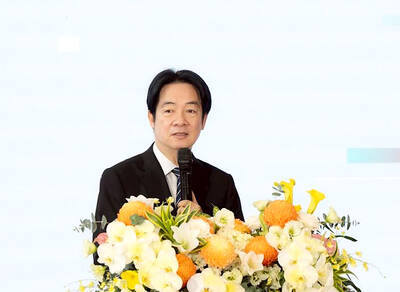A major new report from the US recommends that Taiwan develop its defense industry and be prepared to fight alone if China launches an all-out attack.
Released this week in Washington by the Taiwan Policy Working Group, Deter, Defend, Repel and Partner: A Defense Strategy for Taiwan says that Taipei should be ready to respond to an “array of threats and military contingencies” including intimidating live-fire exercises, a blockade, seizure of an outlying island or a full-scale invasion.
The report stresses that even though cross-strait tensions have been significantly reduced under the administration of President Ma Ying-jeou (馬英九), the Republic of China (ROC) needs to build a military strong enough to make the use of force against it unlikely.
“Taiwan should be able to mount an effective defense and should be able to continue to fight on its own in a drawn-out conflict,” the report said.
“There is much speculation about how the US would react to a Chinese provocation in the Taiwan Strait,” the report said.
“The ROC military certainly hopes that the US would offer assistance, if not intervene more directly. Taipei cannot, however, count on this development. The defense establishment should, then, prepare to fight the PLA [People’s Liberation Army], from the opening shots through the conflict’s resolution, as if it were to defend itself entirely on its own,” the report said.
“Should the PRC attempt to physically occupy Taiwan, the ROC military should be prepared to repel an amphibious invasion; sustain an organized ground defense under central authority further inland; and in a worst-case scenario, be prepared for decentralized resistance,” it said.
The report was written by Dan Blumenthal, an official in former US president George W. Bush’s administration who is now a resident fellow at the American Enterprise Institute (AEI); Michael Mazza, a research assistant in Asian studies at AEI; Gary Schmitt, a resident scholar at AEI and former official in the Reagan administration; Randall Schriver, president of the Project 2049 Institute and former deputy assistant secretary of state for East Asian and Pacific Affairs in the Bush administration and Mark Stokes, executive director of the Project 2049 Institute.
Quoting former US secretary of state Henry Kissinger, the report says that Taiwan, like a guerrilla force, must learn to “win by not losing.”
While the report does not mention specific weapons systems, it argues that a diminished commitment to Taiwan’s defense will reduce Taipei’s leverage in dealing with Bejing and “could make the peaceful resolution of differences less likely in the future.”
“It is our view that a strong ROC defense is essential if future cross-strait discussions are to be carried out with confidence, with mutual respect, and free of intimidation,” it said.
At a press conference to launch the report, Schriver said: “The military buildup opposite Taiwan continues apace. It hasn’t slowed, it hasn’t remained static, it has increased. It compels us to take proactive actions to address that.”
“You help Taiwan with its defense because you want to create an environment and a confidence to engage in meaningful cross-strait diplomacy. No one wants to negotiate with a gun to their head,” he said.
The report was discussed extensively with the Ma administration as it was being prepared.
While the report does say it, the authors made it clear in their presentation that they were in favor of the US selling more F-16s to Taiwan and supporting Taiwan’s quest for a submarine force.
Blumenthal said that if countries like North Korea and Colombia could build their own submarines, then a technologically advanced society like Taiwan could certainly do so.
“We tried to put ourselves in Taiwan’s shoes. The key would be to defend four key domains, the information domain, the air domain, the maritime domain and your own ground,” he said.
“Of course Taiwan needs the upgraded F-16. If you say Taiwan should not have the upgraded F-16 you are saying that Taiwan should not have an air force. People make arguments that fixed wing aircraft and their bases are very vulnerable. But you can disperse and harden your facilities and low and behold your aircraft become more survivable,” Blumenthal said.
“Technology could be leveraged to increase the ROC’s military power. Taiwan is home to a number of industries [in areas such as information technology, nanotechnology and aerospace] in which it excels and that have considerable defense applications,” the report said.
“With focused government investment, Taiwan has the potential to field innovative defense systems. Working with counterparts in the US and elsewhere, Taiwan has opportunities to leverage technological strengths in, for example, microelectronics and materials science and to design, develop and manufacture creative solutions to many of its most vexing military problems,” it said.
“A strong domestic defense industry could create yet another path for Taiwan’s economic growth. With the ROC’s highly innovative workforce and access to worldwide markets, Taiwan’s own defense industry could flourish. The industry would have a ready-made market in Taiwan, precisely because the ROC military is limited in its ability to purchase weapons systems abroad. It would also further diversify options for Taiwan’s own exports,” it said.
“Innovative, high-tech enterprises in Taiwan could become qualified suppliers of components and subassemblies for the US Department of Defense and defense industry. The resulting job creation in Taiwan could shore up support within Taiwan for defense spending,” it said.
William Murray, a China expert at the Naval War College, also present at the launch, questioned Taiwan’s need for more F-16s.
“On the modern battlefield, if you can hide you can survive. But if you are a fixed target you probably face destruction. So, I wonder how aircraft runways can survive in Taiwan. The question is, ‘how do you get them to survive the initial bombardment?’ If you can’t protect the runways, I am not sure what the F-16s do. I agree that the F-16 itself can be survivable but without a runway it is not flyable. I don’t know that it’s the best thing for Taiwan,” Murray said.
The report said Taiwan’s military should have four key missions: Deter coercion; defend against a spectrum of coercive scenarios; repel an invasion and fight a land war; and partner with civilian responders and with foreign militaries.
“Taiwan needs to be able to deter an air campaign by showing it can shoot down PLA Air Force fighters and bombers; severely complicate efforts to establish a maritime blockade; degrade substantially an amphibious attack; and, if necessary, demonstrate it can endure a protracted ground campaign on the island itself,” the report said.
“Taiwan faces the most significant military challenge in the world,” Stokes said.

MISINFORMATION: The generated content tends to adopt China’s official stance, such as ‘Taiwan is currently governed by the Chinese central government,’ the NSB said Five China-developed artificial intelligence (AI) language models exhibit cybersecurity risks and content biases, an inspection conducted by the National Security Bureau (NSB) showed. The five AI tools are: DeepSeek, Doubao (豆包), Yiyan (文心一言), Tongyi (通義千問) and Yuanbao (騰訊元寶), the bureau said, advising people to remain vigilant to protect personal data privacy and corporate business secrets. The NSB said it, in accordance with the National Intelligence Services Act (國家情報工作法), has reviewed international cybersecurity reports and intelligence, and coordinated with the Ministry of Justice Investigation Bureau and the National Police Agency’s Criminal Investigation Bureau to conduct an inspection of China-made AI language

BOOST IN CONFIDENCE: The sale sends a clear message of support for Taiwan and dispels rumors that US President Donald Trump ‘sold out’ the nation, an expert said The US government on Thursday announced a possible sale to Taiwan of fighter jet parts, which was estimated to cost about US$330 million, in a move that an expert said “sends a clear message of support for Taiwan” amid fears that Washington might be wavering in its attitude toward Taipei. It was the first announcement of an arms sale to Taiwan since US President Donald Trump returned to the White House earlier this year. The proposed package includes non-standard components, spare and repair parts, consumables and accessories, as well repair and return support for the F-16, C-130 and Indigenous Defense Fighter aircraft,

CHECKING BOUNDARIES: China wants to disrupt solidarity among democracies and test their red lines, but it is instead pushing nations to become more united, an expert said The US Department of State on Friday expressed deep concern over a Chinese public security agency’s investigation into Legislator Puma Shen (沈伯洋) for “secession.” “China’s actions threaten free speech and erode norms that have underpinned the cross-strait ‘status quo’ for decades,” a US Department of State spokesperson said. The Chongqing Municipal Public Security Bureau late last month listed Shen as “wanted” and launched an investigation into alleged “secession-related” criminal activities, including his founding of the Kuma Academy, a civil defense organization that prepares people for an invasion by China. The spokesperson said that the US was “deeply concerned” about the bureau investigating Shen

‘TROUBLEMAKER’: Most countries believe that it is China — rather than Taiwan — that is undermining regional peace and stability with its coercive tactics, the president said China should restrain itself and refrain from being a troublemaker that sabotages peace and stability in the Indo-Pacific region, President William Lai (賴清德) said yesterday. Lai made the remarks after China Coast Guard vessels sailed into disputed waters off the Senkaku Islands — known as the Diaoyutai Islands (釣魚台) in Taiwan — following a remark Japanese Prime Minister Sanae Takaichi made regarding Taiwan. Takaichi during a parliamentary session on Nov. 7 said that a “Taiwan contingency” involving a Chinese naval blockade could qualify as a “survival-threatening situation” for Japan, and trigger Tokyo’s deployment of its military for defense. Asked about the escalating tensions